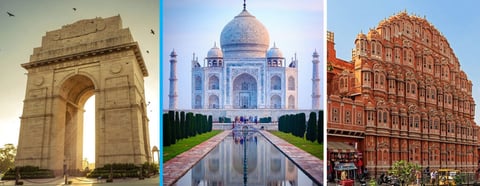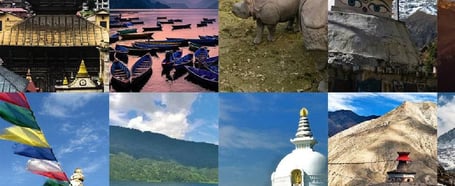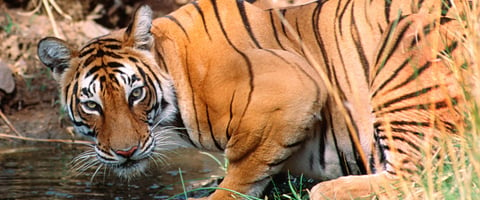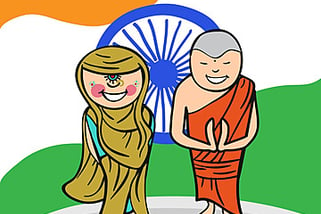ITINERARY INFO :- DELHI – UDAIPUR – JODHPUR – JAIPUR – AGRA – KHAJURAHO -VARANASI – KATHMANDU.
Days 01: ARRIVE DELHI
Today you will arrive at Delhi’s International Airport. Following customs, immigration formalities and baggage collection, our representative will meet and transfer you to your hotel.India’s capital and a major gateway to the country, contemporary Delhi is a bustling metropolis, which successfully combines in its folds – the ancient with the modern. Amidst the fast spiraling skyscrapers, the remnants of a bygone time in the form of its many monuments stand as silent reminders to the region’s ancient legacy. The first impressions for any visitor traveling in from the airport are of a specious, garden city, tree-lined with a number of beautiful parks. Overnight at the hotel.
DAY 02: DELHI
After buffet breakfast at the hotel, you will be taken on a full-day sightseeing tour of New & Old Delhi. The tour will begin with a visit to Raj Ghat, a simple memorial to Mahatma Gandhi; drive past the Red Fort continuing to the Jama Masjid, one of Asia’s largest mosques and which is viewed from the outside.Enjoy Rickshaw ride in Old Delhi Chandni Chowk market. Later you will be driven to New Delhi, which reflects the legacy the British left behind. The tour to Imperial Delhi will include a visit to the Qutab Minar, which is the tallest stone towerin India. It was started in 1199 AD by Qutab-ud-Din Aibak and completed by the sultan’s successor and son-in-law, Iltutmish. The building is 72.5 m high and has 379 steps from the bottom to the top. The Qutab Minar is still the highest stone tower as well as one of the finest Islamic structures ever raised in India. Then visit Humayun’s tomb, built by the widow of the second Mughal Emperor, Humayun, it is an outstanding monument in the IndoPersian style,a precursor of the Taj Mahal. The tour also includeincludees a drive past the imposing India Gate, the Parliament building and the Rashtrapati Bhawan, the President’s residence.Overnight at the hotel.
Day 03 – DELHI – UDAIPUR (AIR) – After breakfast, transfer to the airport for boarding to UDAIPUR. Arrival, transfer to the hotel. Afternoon free for leisure activities. Dinner and overnight at the hotel.
DAY 04 – UDAIPUR – Breakfast, sightseeing tour of Udaipur. You will visit the City Palace, built by the rulers of Mewar. This magnificent palace nestled in the bosom of Aravallis. Surrounded by lush greenery, City Palace is a perfect fusion of architecture and heritage. You will then head to Jagdish Temple, dedicated to Lord Vishnu. This temple is a perfect blend of Indo-Aryan architectural style. The temple is situated in the City Palace complex. Later, you will visit Saheliyon ki Bari, a majestic garden located on the banks of Fateh Sagar lake. With lush green gardens, captivating fountains and enchanting lotus pools, Saheliyon ki Bari offers a glimpse into the lifestyle of royal maidens. In the evening, you can go boating on Lake Pichola (optional). Lake Pichola is a Paradise for nature lovers. This is an artificial lake that is bordered by towering hills, historical monuments and bathing ghats. After the sightseeing tour, return to the hotel. Dinner and overnight at the hotel.
05 DAY – UDAIPUR – RANAKPUR – JODHPUR – After breakfast, head to Jodhpur. On the way, you can choose to stop at Ranakpur, a village popularly known for its Jain temples. Jodhpur is the city known for its blue vibe and historical importance. Once you enter the city, we will check in at the hotel. Overnight stay.
06 Day – JODHPUR – After breakfast, proceed to the local tourist attractions of Jodhpur and explore one of the largest forts in India, Mehrangarh Fort. Followed by a visit to Phool Mahal, Jaswant Thada. Dinner and overnight.
07 Day – JODHPUR – JAIPUR – After breakfast, travel to Jaipur. Upon arrival Jaipur transfer to hotel. Afternoon free for leisure activities. Dinner and overnight.
08 Day – JAIPUR – After breakfast visit the city: Amer Fort is the first place you will discover on an elephant ride. Next is a visit to the City Palace, which was built by Maharaja Sawai Jai Singh II. It has several gardens, museums, temples, buildings and courtyards to capture on camera. After the sightseeing tour, return to the hotel. Dinner and overnight.
DAY 09 – JAIPUR – FATEHPUR SIKRI – AGRA – After breakfast, travel to Agra. On the way, there will be a quick stop at Fatehpur Sikri. It is a city that was a gift from a Mughal emperor in the second century of the 16th century. Upon arrival in Agra, visit the Taj Mahal and Agra Fort. Dinner and overnight at the hotel.
DAY 10 – AGRA SIGHTSEEING
DAY 11 – AGRA – ORCHHA - KHAJURAHO – After breakfast in the hotel, drive to Khajuraho by road via visiting orchha and upon arrival
check in at hotel. Orchha – Chaturbhuj temple, dedicated to Vishnu, is situated at Orchha in Madhya Pradesh, India. The name Chaturbhuj is a combination of ‘chatur’ meaning “four” and ‘bhuj’ meaning “arms”, which literally translates as “one who has four arms” and refers to Rama, an avatar of Vishnu. The temple is dedicated to the goddess Lakshmi, the Hindu goddess of wealth. Built by Bir Singh Deo in 1622, Sri Lakshmi Narayan Temple is one of the three most important temples in Orchha and also an interesting tourist attraction of the place. Inside the inner chambers of the temple, Vir Singh made arrangements to offer sacrifices for Lakshmi. But due to improper maintenance, the condition of the temple soon worsened. It was rebuilt by Prithvi Singh during 1793. The Puranic name of Amarkantak was Riksha parvat. It is not only the Narmada that arises from Amarkantak, for the River Son, initially called Jwalawanti of Johila, the Mahanadi and the Amadoh, which is one of the main tributaries of the Godavari, all arise from within the Amarkantak plateau. Sacred rivers of India, the Narmada occupies a unique place. Legend has it that Lord Shiva blessed Narmada with unique purifying powers. While, to purify himself, a devotee requires taking a bath in the Holy Ganges, seven days of prayer on the banks of the Yamuna and three days of prayer on the banks of the Saraswati, the mere sight of Narmada is enough. A charming folk tale describes the superiority of Narmada over Ganges. Once a year, after she contaminates herself beyond tolerance, Ganga visits Narmada dressed as a dark woman and takes a purifying bath in her waters. Narmada, which is more than 150 million years older than the Ganges River and is considered by many Hindus to be the most sacred of all rivers in India, Amarkantak itself is sacred to Hindus and is considered a gateway to ‘nirwana’. ‘.Overnight at the hotel in Khajuraho.
DAY 12 – KHAJURAHO SIGHTSEEING AND PANNA NATIONAL PARK AFTER BFEAKFAST AT THE HOTEL, PROCEED TO VISIT THE TEMPLE OF KHAJURAHO AND THEN IN THE AFTERNOON LUNCH AT THE LOCAL RESTAURANT AND IN THE EVENING PROCEED TO VISIT THE PANNA NATIONAL PARK.Overnight and dinner at hotel.Khajuraho – Shantinatha Temple is a Jain temple declared a World Heritage Site along with the Khajuraho Group of Monuments. The temple is presided over by Shantinatha; However,it also has idols of other Jain tirthankaras, including a colossal statue of Adinatha. The temple has been renovated but still retains inscriptions from bygone eras. Built around 960 AD. During the reign of King Chandela Dhanga and originally dedicated to Adinatha, the Parshvanatha temple is one of the finest monuments in Khajuraho.
DAY 13 – KHAJURAHO – VANARASI After breakfast in the hotel, drive to Varanasi or by flight ( whichever option is available we will provide you ). Upon arrival check in at hotel. In the night, attend the ganga aarti and enjoy the night sightseeing .Overnight at hotel.
DAY 14– VARANASI – After breakfast, take a boat ride on the sacred river Ganga and sit for some time on the ghats. Return to your hotel and enjoy breakfast. At the end of the day, take a tour of Sarnath, which is the place where Gautama Buddha taught his first sermon. Return to Varanasi and visit popular temples including Bharat Mata Temple, Tulsi Manas Temple and Alamgir Temple. In the evening, you will visit Bharat Hindu University to see the collection of Indian paintings, archaeological artifacts, Indian philately and textiles. Dinner and overnight at the hotel.
DAY 15 – VARANASI – KATHMANDU – After breakfast, transfer to Varanasi airport. Flight to Nepal. Arrival in Kahtmandu. Reception by our guide and transfer to the Hotel. In the afternoon half-day tour of: Kirtipur: A small town is situated on a ridge 6 km southwest of Kathmandu. The ancient town established in 1099 is a natural fortress and has a proud and courageous history. It was the first place to be attacked by Prithvi Narayan Shah in 1768. Chilamchu stupa and Bagh Bhairav temple are the main tourist spots here. Kirtipur offers picturesque streets lined with artistic houses and temple squares and great views of the Kathmandu Valley. The people are known for their skill in building and weaving and other ancient looms. Chovar: Carved into the side of a hill, the Chovar gorge is the only outlet for all the waters of the valley. Legend has it that Manjushree, an ancient saint cut the mountain with his magic sword, to drain the water from the Kathmandu valley, which at that time was just a lake. There is a small but picturesque temple of Adinath on top of the hill with a magnificent view of the snow-capped peaks. Just beyond the gorge is a temple of Lord Ganesh. The mainimage of the sanctuary is a massive, naturally carved rock. Dinner and overnight at the hotel.
DAY 16 – KATHMANDU – After breakfast, departure for a full day tour of Swoyambhunath. The four eyes of the Swoyambhunath Stupa watch over the valley from the top of a 77 m high hill on the western side. This most glorious stupa in the world is one of the most sacred Buddhist sites in Nepal and its establishment is linked to the creation of the Kathmandu Valley from a primordial lake. The surroundings of Swoyambhunath are covered with small Chaityas and monasteries as well as some Hindu temples. The National Museum and the Natural History Museum are located at the foot of the hill. Kathmandu Durbar Square: This complex of palaces, courtyards and temples, built between the 12th and 18th centuries, used to be the residence of the ancient Malla kings of Kathmandu. It is
the place where the kings of Nepal are crowned and their coronations are solemnized. An intriguing piece here is the 17th-century stone inscription placed on the palace wall with writings in 15 languages. Kumari Temple: The Kumari temple is the residence of the Living Goddess. Kumari, known as the Virgin Goddess, has some specialties, she must be chosen from a typical cast of Newari without marks and bodily injuries and will be replaced by another Kumari after puberty. Kasthamandap: Kasthamandap is believed to have been built from the wood of a single tree in the 16th century, situated near the Kumari Temple. The name Kathmandu was named after this temple. Patan City: The ancient city, once a kingdom in itself, is situated across the Bagmati River, south of Kathmandu. Patan Durbar Square offers the best display of Newari urban architecture in Nepal. There are temples dedicated to Shiva, Krishna, Ganesh and Vishnu, all of which are actively visited by residents and visitors. At the north end of the square, the ancient sunken tap has been restored and is still used by girls who fill huge jugs from the carved stone spouts. The courtyards of the Royal Palace, with their ornate windows, columned arcades, sanctuaries and submerged royal baths, are among the most beautiful in Kathmandu. Dinner and overnight.
DAY 17 – KATHMANDU – After breakfast, proceed for an excursion to: Changu Narayan: Narayan, or Vishnu, is the preserver of creation for Hindus. His temple near Changu village is often described as the oldest temple in the Kathmandu Valley. A 5th-century stone inscription, the oldest to be discovered in Nepal, is located in the temple complex and speaks of the victorious king Mandev. The temple now covers sixteen hundred years of Nepalese art history. The temple, built around the 3rd century, is decorated with some of the finest samples of stone, wood and metal craftsmanship in the Valley. In the words of a tour guide, “When you look at Changu Narayan, you see the complete cultural development of the Valley.” On the supports of the two-tier Changu Narayan Temple are the ten incarnations in which Narayan destroyed evildoers. A 6th-century stone statue shows thecosmic form of Vishnu, while another statue recalls his dwarf incarnation when he crushed the evil king Bali. Vishnu as Narasingha disemboweling a demon is particularly impressive. The western bronze doors gleam in the afternoon sunlight, dragons decorate the bells, and beautiful devas gaze from the walls. Garuda, half man and half bird, is Vishnu’s steed, and his life-size statue is kneeling before the temple. The favorite of many tourists is the statue of Vishnu riding his steed. Bhaktapur Durbar Square: Upon entering, you cannot help but be overcome by a feeling of inner harmony. That’s the art, the architecture, and the special layout here. The 55-window palace built during the period of King BhupatindraMalla in 1754, situated on the left as you enter the city gate, inspires awe. The National Art Gallery is also located inside. The entrance to the palace, the Golden Gate known as SunkoDhoka in Nepali, is a masterpiece of repousse art. In front of the palace building there is a mix of temples of various designs. Among the three Durbar Squares in the Valley, the Durbar Square in Bhaktapur is the best preserved. Nagarkot: Located 32 kilometers east of Kathmandu, it is one of the most scenic spots in Bhaktapur district and is known for its spectacular view of the Himalayan sunrise when the weather is clear. Visitors often travel from Kathmandu to Nagarkot for the night so they can be there for the breathtaking sunrise. Nagarkot has become famous as one of the best places to see Mount Everest, as well as other snow-capped peaks of the Himalayan range in eastern Nepal. It also offers a great view of the Indrawati river valley to the east. At an altitude of 2,195 meters, Nagarkot also offers a panoramic view of the valley and is described by visitors as a place whose beauty endures throughout the year. To have lunch. OVERNIGHT A D DINNER AT HOTEL.
DAY 18 – KATHMANDU – TO YOUR DESTINATION. AFTER BREAKFAST AT THE HOTEL, DRIVE TO AIRPORT TO CATCH A FLIGHT TO YOUR DESTINATION WITH SWEET MEMORIES OF INDIA. END OF SERVICE.
INCLUDES IN THE PRICE: 17 nights’ accommodation in listed or similar hotels, daily breakfast and dinner at the hotel. Air-conditioned transport for all transfers and tourist tours; spanish speaking guides; all fees for visiting monuments according to the itinerary; Rickshaw ride through old bazaar of Old City Delhi Elephant/jeep ride at Amber Fort Palace in Jaipur Dance show with dinner (ubaipur and Jaipur) Packed drinking water during tours, tours and Excursions.Flight Ticket: Delhi to Udaipur and Vanarasi to Katmandu ( via delhi ) , Boat Trip on River Ganges, Aarti Ceremony on Ganges at Night. Train ticket – Agra.
Not included – Return ticket Visa Other personal expenses.








